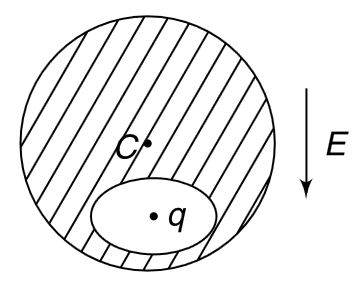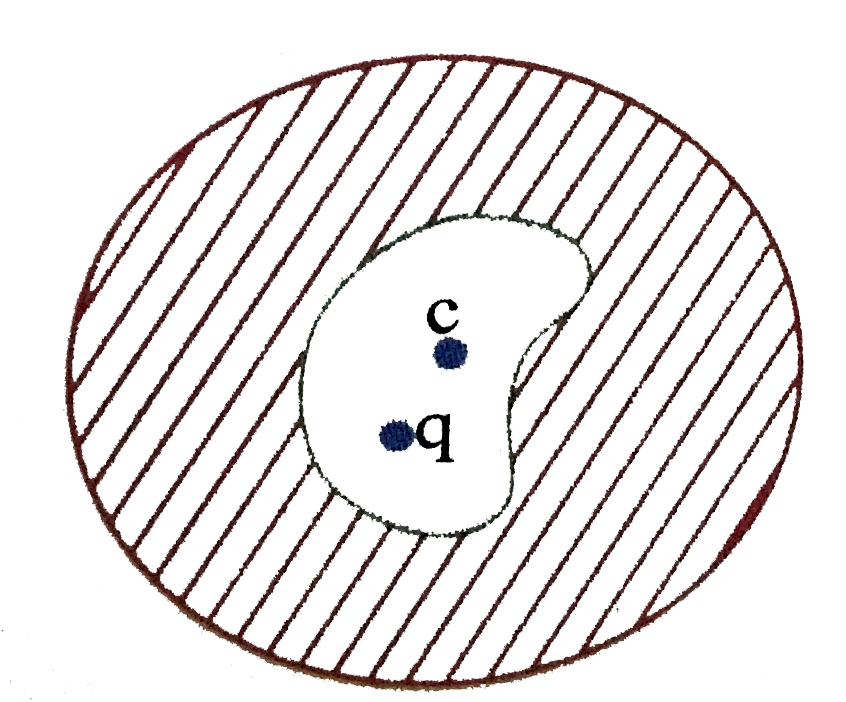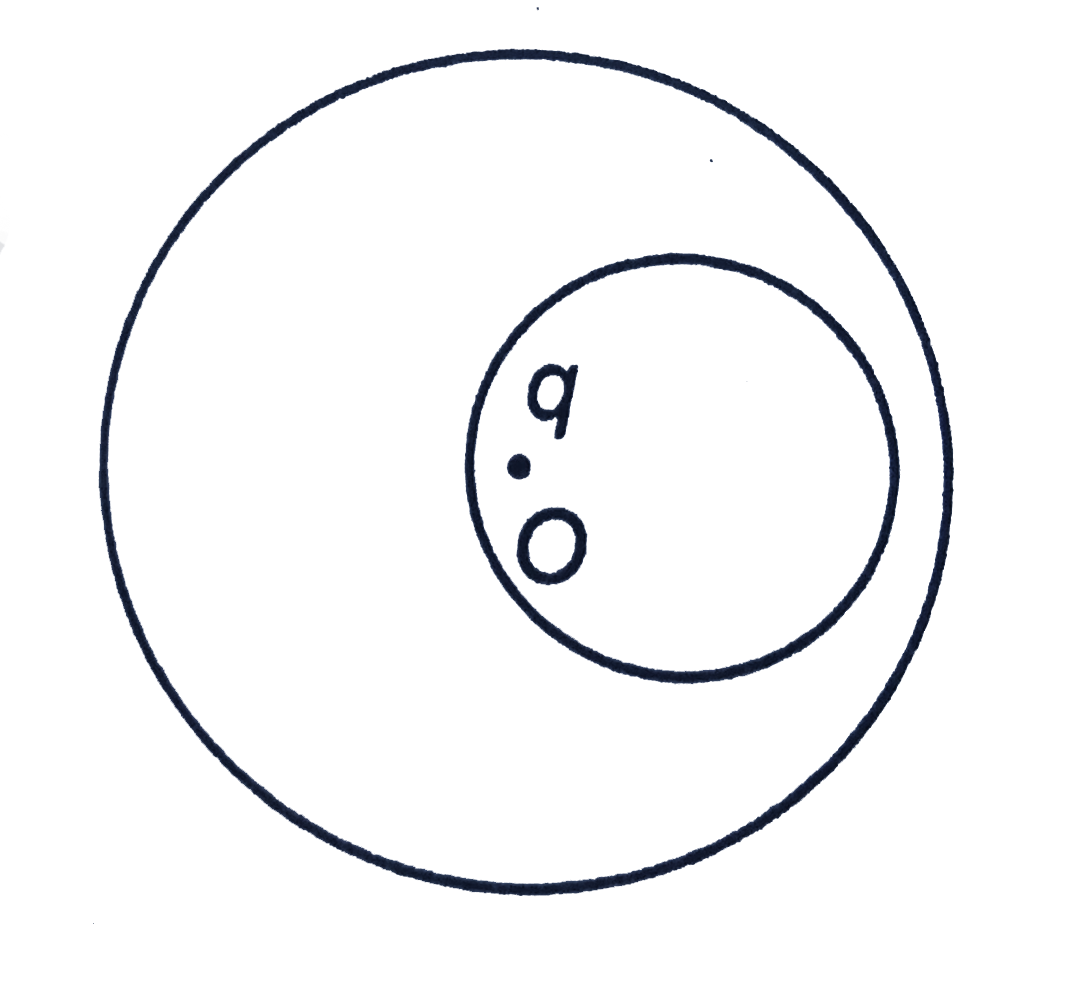The figure shows a charge q placed inside a cavity in an uncharged conductor. Now if an external electric field is swiched on

only induced charge on outer surface will redistribute
only inducrd charge on inner surface will redistribute
both induced charge on outer and inner surface will redistribute
force on charge q placed inside the cavity will change
The correct Answer is:A
Topper's Solved these Questions
- ELECTROSTATICSBOOK - AAKASH SERIESCHAPTER - ELECTROSTATICSEXERCISE - PRACTICE SHEET (EXERCISE -III ELECTRO FLUX & GAUSS.S LAW) (LEVEL - I (ADVANCED) MORE THAN ONE CORRECT ANWER TYPE QUESTIONS
5 Videos
- ELECTROSTATICSBOOK - AAKASH SERIESCHAPTER - ELECTROSTATICSEXERCISE - PRACTICE SHEET (EXERCISE -III ELECTRO FLUX & GAUSS.S LAW) (LEVEL - I (ADVANCED) LINKED COMPREHENSION TYPE QUESTIONS)
3 Videos
- ELECTROSTATICSBOOK - AAKASH SERIESCHAPTER - ELECTROSTATICSEXERCISE - PRACTICE SHEET (EXERCISE -III ELECTRO FLUX & GAUSS.S LAW) (LEVEL - I (MAIN) STRAIGHT OBJECTIVE TYPE QUESTIONS)
9 Videos
- ELECTROMAGNETICSBOOK - AAKASH SERIESCHAPTER - ELECTROMAGNETICSEXERCISE - ADDITIONAL EXERCISE
6 Videos
- ELEMENTS OF VECTORSBOOK - AAKASH SERIESCHAPTER - ELEMENTS OF VECTORSEXERCISE - QUESTIONS FOR DESCRIPTIVE ANSWERS
9 Videos
Similar Questions
The electric field inside a conductor
View SolutionA neutral spherical conductor has a cavity. A point charge q is located inside it. It is in equilibrium. An external electric field (E) is switched on that is directed parallel to the line joining the centre of the sphere to the point charge. (a) What is the direction of acceleration of the charge particle inside the cavity after E is switched on. (b) How is the induced charge on the wall of the cavity affected due to the external field.

View Solution
Knowledge Check
the figure shows a charge q placed inside a cavity in an uncharged conductor, Now if na external electric field is switched on
 AOnly induced charge on outer surface will redistributeBOnly induced charge on inner surface will redistributeCboth induced charge on outer and inner surface will redistributeDforce on charge q placed inside the cavity will change.
AOnly induced charge on outer surface will redistributeBOnly induced charge on inner surface will redistributeCboth induced charge on outer and inner surface will redistributeDforce on charge q placed inside the cavity will change.What happens when a conductor is placed in an external electric field?
AThe free charge carriers move and charge distribution In the conductor adjusts Itself In such a way that the electric field due to Induced charge opposes the external field within the conductorBIn the static situation, the two fields cancel each other and the electrostatic field In the conductor Is zeroCBoth (1) and (2)DNeither (1) nor (2)When an excess charge is placed on an isolated conductor, it will distribute itself on the surface of that conductor so that all points of conductor whether on the surface or inside the conductor becomes to same potential. This is true even if there is a cavity inside the conductor. If an isolated conductor is placed in an external electric field, all points of conductor still come to a single potential regardless of whether the conductor has an excess charge. The free electrons distribute themselves on the surface in such a way that the electric field they produce at interior point cancels the external field that would otherwise be there.
In electrical field, equipotential surfaces mustAbe plane surfacesBbe tangential to the direction of fieldCbe spaced such that surfaces having equal difference in potential are separated by equal distanceDhave decreasing potential in the direction of field
Why is electric field intensity inside a charged conductor zero ?
View SolutionA positive point charge (+q) is kept in the vicinity of an uncharged conducting plate. Sketch electric field lines originating from the point on to the surface of the plate.
Derive the expression for the electric field at the surface of a charged conductor.
View SolutionA positive point charge (+q) is kept in the vicinity of an uncharged conducting plate. Sketch electric field lines originating from the point on to the surface of the plate.
Derive the expression for the electric field at the surface of a charged conductor.
View SolutionWhen an excess charge is placed on an isolated conductor, it will distribute itself on the surface of that conductor so that all points of conductor whether on the surface or inside the conductor becomes to same potential. This is true even if there is a cavity inside the conductor. If an isolated conductor is placed in an external electric field, all points of conductor still come to a single potential regardless of whether the conductor has an excess charge. The free electrons distribute themselves on the surface in such a way that the electric field they produce at interior point cancels the external field that would otherwise be there.
Choose the incorrect charge distribution
View SolutionA charge q is placed at O in the cavity in a spherical uncharged conductor. Points S is outside the conductor. If q is displaced from O towards S (still remaining within the cavity)

View Solution
